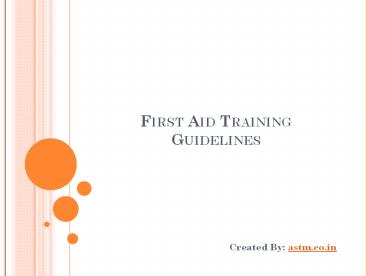First Aid Training Guidelines - PowerPoint PPT Presentation
Title:
First Aid Training Guidelines
Description:
The First Aid is immediate care provided to a person who has been injured or has been suddenly ill. – PowerPoint PPT presentation
Number of Views:392
Title: First Aid Training Guidelines
1
First Aid Training Guidelines
- Created By astm.co.in
2
Index
- What is First Aid
- Why First Aid Training Required
- What does they teach in First Aid Training
- Key Aims of First Aid can categories in Three Key
Points - Prevents the situation from becoming worse
- First Aid Training
- Basic First Aid Training Guidelines
3
What Is First Aid?
- The First Aid is immediate care provided to a
person who has been injured or has been suddenly
ill. - It includes both self-help and home care if
medical assistance is not available or delayed.
4
Why First Aid Training Required?
- The first aid training required because whether
you are working in an office or a construction
site, it has two common traits valuable employees
who may injure or become ill and the need to
protect them with first aid procedures. - There are many First Aid Training Providers such
as ASTM Pvt Ltd is one of them.
5
What Does They Teach In First Aid Training?
- First Aid trainers teach basic skills to employee
or to worker. - Such as Required skills, common ailments
requiring first aid like electrical shocks,
cardiac arrest, fractures, etc., administering of
CPR, types of knots and bandages, lifting
techniques.
6
key aims of first aid can categories in three key
points
- 1. Preserve Life
- The preponderant aim of all medical care which
includes first aid is to save lives and minimize
the threat of death.
7
- 2. Prevent Further Harm
- Prevent further damage also sometimes called
avoid the condition from worsening, or risk of
further injury, which covers both external
factors, such as moving a patient away from any
cause of harm and applying first aid techniques
to stop worsening of the condition, such as
applying pressure to stop a bleed.
8
- 3. Promote Recovery
- To start the recovery process from the sickness
or injury, and in some cases might involve
completing treatment, such as in the case of
applying a plaster to a small wound.
9
Prevents the situation from becoming worse
- The trained person know how to keep the situation
from becoming bad to worse. - They will provide temporary treatment which will
keep the condition of the victim from
depreciating, till expert help arrives.
10
First Aid Training
- First aid knowledge and skills promote safety
awareness in home, at work, at play, on streets
and highways. - Taking first aid training a person is prepared to
assist others wisely. - He is able to distinguish between what to do and
what not to do.
11
Basic First Aid Training Guidelines
- Key Components of primary observation
- 1. Breathing
- 2. Airways
- 3. Circulation
12
- Breathing
- 1. Can victim speak?
- 2. Look, at chest rising and falling?
- 3. Listen, do you hear air going in and out of
airways? - 4. Feel, do you feel air touching your chhek?
13
- Airway
- 1. Is it open and functional
- If not correct. Consider cause or mechanism
of injury. - 2. Airways may be obstructed.
14
- Circulation
- 1. To determine a heartbeat.
- Is breathing or movement present? If not
assume to heartbeat and start CPR. - 2. Control severe bleeds with the pressure
dressing immediately.
15
Thank You































